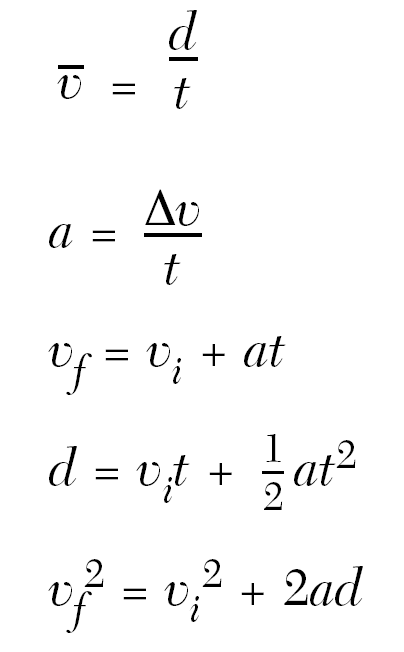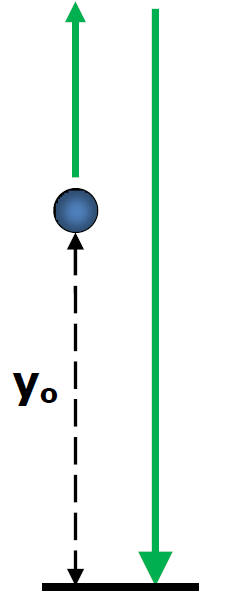![]()
![]()

Freefall Problems
|
Why would a crumpled piece of paper dropped from a height of 3 m have a greater acceleration than an uncrumpled one.? |
What is a vacuum?
Brain Bites - NASA
School blocks YouTube?
Download file below.
Video Instruction
showmethephysics.com
B. Free fall - falling where the only force is gravity (no friction)
1. Free fall Word Problems
 |
"Use same method and equations as before, except always remember when you read... " |

Vi = 0
a = g = +9.8m/s2
(make down +)
…
an object is ascending:

a
= g = -9.8 m/s2
(make down -)
V vs t plot, Object Ascending?
Ex) Object thrown up Vi
= 110 m/s,
sketch a V vs t plot of the object
from the throw to the peak (use a = -10 m/s2)

|
|
a. Simple Freefall Problems
|
Leaning Tower of Pisa, in Pisa, Italy.
(Wednesday 19 May 2004, 17:37) |








|
Ex) A coin is dropped in a vacuum tube, find its displacement after .30 seconds. |
 |
"Step 1 - Read and underline all the important information" |
Ex) A coin is dropped in a vacuum tube, find its displacement after .30 seconds.

 |
"Step 2 - Turn all your information into letters" |
Vi = 0
(Object is dropped)
a = +9.8 m/s2
d = ?
t = .30 seconds

 |
"Step 3 - Substitute and Solve" |

d = Vit + 1/2at2
d = 0m/s(.30 sec)+1/2(9.8 m/s2)(.30 s)2
d = 0 + 4.9(.09)
d = .44 m
Ex) A coin is dropped in a vacuum tube, find the coin's velocity after .30 seconds
Ex) A coin is dropped in a vacuum tube, find the coin's velocity after .30 seconds
Vi = 0 m/s
a = +9.8 m/s2
(dropped)
Vf = ?
t = .30 sec
 |
"Search the Mechanics Section on the equation sheet to find the equation that fits" |
Vf = Vi + at
OR
a = (Vf - Vi)/t
Vf = 0 + 9.8 m/s2(.3 sec)
Vf = 2.9 m/s
Ex) A rocket is fired vertically upward with an initial velocity of 29 m/s.
Find the rocket's maximum altitude.
|
At Maximum Altitude,
Vf = 0 m/s
|
Ex) A rocket is fired vertically upward with an initial velocity of 29 m/s .
Find the rocket's maximum altitude.
Altitude??

Vi = +29 m/s
Vf = 0 m/s
a = g = -9.8 m/s2
d = ?
Vf2 = Vi2
+ 2ad
0 = 841 + -19.6d
-841 = -19.6d
43 m
Uniform or Non-uniform Acceleration?

|
Ex)
An object dropped on planet X falls 64 m in 4 seconds. |
Ex) An object dropped on planet X falls 64 m in 4 seconds. Find the acceleration due to gravity on planet X.
Vi=
0 m/s
d = 64 m
t = 4 sec
a = ?
d = Vit + 1/2 at2
64 m = 0 m/s(4 sec) + 1/2a(4
sec)2
64 m = 0 + 8a
a = 8 m/s2
AP Question
A ball is thrown upward from a position (y0)above the ground with a velocity of 16 m/s.
Find y0 if it took 3.0 seconds for the ball to hit the ground.

A ball is thrown upward from a position (y0) above the ground with a velocity of 8 m/s.
Find y0 if it took 3.0 seconds for the ball to hit the ground.

ay = -10. m/s2 (g)
yi = ?
Vi = 8 m/s
yf = 0 (hit the ground)
t = 3.0 sec
∆d = Vit + 1/2at2
yf - yi = Vit + 1/2at2
y = yi + Vit + 1/2at2
0 = yi + 8 m/s(3.0 sec) + 1/2(-10.m/s2)(3.0 sec)2
0 = yi + 24 m + -45 m
-yi = 24 m + -45 m
-yi = -21 m
yi = 21 m
What velocity does the ball to hit the ground?

Make down positive
Make this a problem of a ball falling from a height of 21 m and a velocity of 8 m/s down
ay = +10. m/s2 (g)
∆d = +21 m
Vi = +8.0 m/s
(vel. become +8 m/s when ball returns to original position)
Vf = ?
Vf2 = Vi2 + 2ad
Vf2 = 64 + 2(10 m/s2)21m
Vf = 22 m/s down
OR
Vf = 8.0m/s + -10m/s2(3 sec)
Vf = -22 m/s
Paul Hewitt Question
When you drop a ball it accelerates downward at 9.8 m/s2. If you instead throw it downward, then its acceleration immediately after leaving your hand, assuming no air resistance, is
A. 9.8 m/s2.
B. more than 9.8 m/s2.
C. less than 9.8 m/s2.
D. Cannot say, unless the speed of throw is given.
Ex) A basketball player jumped straight up to grab a rebound. If she was in the air for 0.80 second, how high did she jump?
Treat this as a problem where the player comes down from the peak of her rebound.
ay = 10. m/s2 (g)
d = ?
Vi = 0 m/s
t = .40 sec
∆d = Vit + 1/2at2
∆d = 1/2(10 m/s2)(.4 sec)2
∆d = .80 m
Ex) A stone is thrown vertically upward with a speed of 12.0 m/s from the edge of a cliff 70.0 m high.
a) how long does it take to reach the bottom of the cliff?
t = ? (how long)
ay = 9.80 m/s2 (down positive)
Viy = -12.0 m/s2
∆dy = +70.0 m (down positive)
∆dy = Viyt + 1/2ayt2
70.0 m = -12.0 m/s2t + 4.9 m/s2t2
0 = -12.0 m/s2t + 4.9 m/s2t2 - 70 m
Quadratic, positive root = 5.20 sec
![]()
©Tony Mangiacapre., - All Rights Reserved [Home]
Established 1995
Use any material on this site (w/ attribution)


